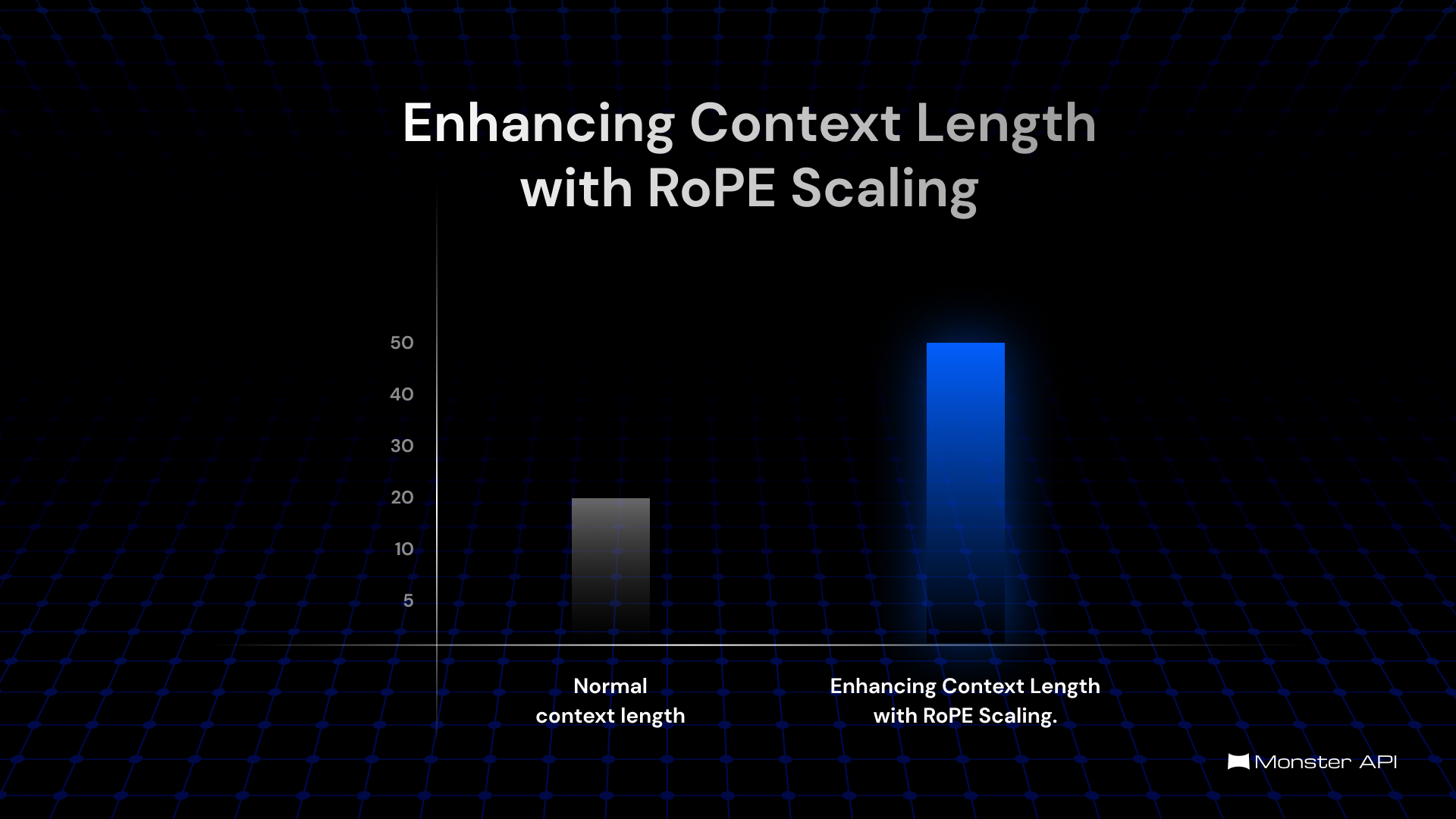Enhancing LLM Context Length with RoPE Scaling
Scaling is a fundamental necessity in the development and application of Large Language Models (LLMs) for several compelling reasons.

Every year, LLMs are becoming more sophisticated. One of the methods to make an LLM more sophisticated is RoPE Scaling. Imagine you’ve trained an LLM to give you 10-word sentences, but what if you one day throw a 50-word sentence at it? Most likely the LLM may struggle with content and the order of words.
In this blog, we’ll be talking about RoPE scaling in LLMs and how you can use it to significantly improve the context lengths of LLMs.
The Need for Context Scaling in LLMs
Scaling is a fundamental necessity in the development and application of Large Language Models (LLMs) for several compelling reasons:
- Handling Longer Contexts:
- Real-World Applications: Many tasks, such as document summarization, long-form content generation, and legal text analysis, require understanding and processing long sequences of text. Traditional LLMs, trained in shorter contexts, often fail to manage these effectively. Scaling allows models to handle longer contexts, making them more applicable and useful in real-world scenarios.
- Maintaining Coherence: For applications like chatbots and narrative generation, maintaining coherence over extended dialogues or stories is crucial. Scaling helps in retaining context over longer sequences, ensuring more coherent and contextually relevant responses.
- Performance Improvement:
- Reducing Perplexity: Scaling LLMs can significantly reduce perplexity over longer texts, improving the model's ability to predict and generate text accurately across extended sequences.
- Enhancing Accuracy: With improved handling of longer contexts, LLMs can achieve higher accuracy in tasks that require a deep understanding of extended text, such as question answering and summarization.
- Addressing Limitations of Current Models:
- Mitigating Performance Drop: One of the significant challenges with traditional LLMs is the performance drop when processing sequences longer than their training context. Scaling mitigates this issue by extending the model's effective context length, thereby maintaining performance even with longer inputs .
- Enhanced Extrapolation: Scaling techniques, such as RoPE Scaling, enhance the model's ability to extrapolate beyond its training length, providing more accurate and reliable outputs for long-context tasks .
What is RoPE Scaling?
RoPE Scaling refers to the adjustment of Rotary Position Embedding (RoPE) parameters to enhance the extrapolation capabilities of Large Language Models (LLMs) beyond their original training context lengths.
This technique is used to improve the ability of LLMs to handle longer sequences of text than those seen during training by modifying the base value used in the RoPE calculations. The process involves fine-tuning the RoPE with either a smaller or larger base value to better capture positional information over extended contexts, thereby improving the model's performance on tasks involving long text sequences
Key Components of RoPE Scaling
- Rotary Base Value (β): This is a critical parameter in RoPE. Adjusting the base value can significantly impact the model's ability to extrapolate. Larger bases are used to extend the context window, while smaller bases help in achieving more precise extrapolation.
- Critical Dimension (dextra): This represents the dimension up to which the RoPE can capture periodic information effectively. It plays a key role in determining how well the model can extrapolate beyond its training context.
- Fine-Tuning Length (Ttune): The context length used during fine-tuning is crucial for RoPE scaling. Fine-tuning LLMs with longer context lengths helps the model adapt better to extended contexts during inference.
- Extrapolation Strategies: Techniques such as Dynamic NTK, fixed NTK, and Linear Position Interpolation are used in conjunction with RoPE scaling to further enhance extrapolation capabilities.
The Process of RoPE Scaling
- Identifying the Baseline: Determine the original RoPE parameters and the performance of the model on the given context length.
- Adjusting the Rotary Base: Modify the base value (β) to either a larger or smaller value. Larger values are typically used to extend the context window, while smaller values help in precise adjustments for extrapolation.
- Fine-Tuning: Fine-tune the model using the adjusted RoPE parameters. This involves training the model on a dataset with the new context length, which is longer than the original training context.
- Evaluation: Evaluate the model's performance on long-context tasks to ensure that the adjustments have successfully improved extrapolation capabilities.
- Iterative Refinement: Based on the evaluation results, iteratively refine the base value and fine-tuning length to optimize the model's performance on long-context tasks.
Importance of RoPE Scaling in Large Language Models (LLMs)
RoPE (Rotary Position Embedding) Scaling is essential in Large Language Models (LLMs) for several reasons:
- Enhanced Extrapolation Capability
Overcoming Training Length Limitations: Traditional position embeddings often struggle with sequences longer than the training context. RoPE Scaling adjusts the embedding parameters to extend the model's capability beyond its original training length, enabling it to handle much longer sequences effectively.
Maintaining Performance: By fine-tuning with adjusted RoPE parameters, LLMs can maintain low perplexity and high accuracy even as the context length increases, which is critical for tasks requiring long text generation or understanding.
- Improved Long-Context Understanding
- Tasks Involving Long Texts: Many real-world applications, such as document summarization, legal text analysis, and book generation, require understanding and generating long texts. RoPE Scaling ensures that LLMs can effectively manage these tasks by improving their ability to handle longer contexts.
- Better Representation of Positional Information: Adjusting the rotary base value allows the model to better capture positional relationships over extended sequences, leading to more accurate and coherent outputs in long-context tasks.
- Broadening the Applicability of LLMs
- Versatile Applications: With improved extrapolation capabilities, LLMs can be applied to a wider range of applications that were previously limited by context length. This includes chatbots, content generation, and complex query-answering systems that require understanding long sequences of text.
- Future-Proofing Models: As the demand for processing longer sequences grows, RoPE Scaling provides a method to future-proof LLMs, ensuring they remain useful and effective as requirements evolve.
- Performance Consistency
- Stable Attention Scores: RoPE Scaling helps maintain stable attention scores across extended contexts, reducing the risk of performance degradation that occurs when models encounter sequences longer than they were trained on.
- Critical Dimension Utilization: By identifying and utilizing the critical dimension (dextra), RoPE Scaling ensures that the model's positional embeddings remain reliable and well-trained, even for longer contexts.
Conclusion
RoPE Scaling is a crucial technique when it comes to Fine-tuning Large Language Models. With RoPE Scaling, you can build more powerful and efficient AI systems. As researchers and engineers continue to innovate and optimize, the potential of LLMs will expand, opening endless possibilities for AI-driven applications.
Understanding and implementing RoPE Scaling is essential for anyone involved in developing and deploying advanced language models.

